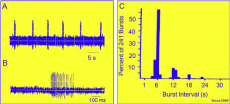

Central Pattern Generators
Why is movement important?
We need movement for various processes such as eating, breathing walking, running reproduction and so much more.
We can use models to help us with our understanding of neuronal processes involved with movement.
Advantages of invertebrate models
Invertebrates have very simple nervous systems with relatively low numbers of types of neurons, and low numbers of each type. We can then use these invertebrates to study motor behaviour whilst it is happening. Invertebrates have identified neurons, these are neurons that are the same size, same shape and are in the same place and therefore do the same job.
Disadvantages of invertebrate models
There are some disadvantages to invertebrates however. A lot of molecular and genetic techniques we use are not developed for many invertebrate models. Additionally, some neurons have complex morphology. Furthermore, there is quite a significant difference between invertebrate models and us humans. Their signalling systems are rather different and their organisation of the nervous system too.
Advantages of vertebrate models
Most importantly, vertebrate models have direct applicability to humans. There are various ways to exploit molecular techniques, for example gene knockouts in mice.
Disadvantages of invertebrate models
Problems that were of big difficulty have been largely overcome in recent years. For example, the vertebrate nervous system being highly complex used to be a significant problem. There are so many neurons and so many different types, as well as a great redundancy. It was hard to manipulate a population of many neurons. Optogenetics has helped massively.
To study behaviour, we must know what we are looking for and therefore define that behaviour.
In the 19th/20th century there were debates as to how rhythms were generated in the first place. The Reflex Hypothesis was proposed and this suggested that a sequence of reflexes generated rhythmic movement. Alternatively, there was the Central Hypothesis. This suggested that central circuits exist, which have the right connectivity and properties, that in the absence of sensory feedback, could generate the correct sequence of muscle contractions and movements.
Then there was the distinguishing test, what happens in the absence of sensory feedback. Well the Reflex Hypothesis would say that everything would stop. Whilst the Central Hypothesis would say that everything would continue as normal. However, they were both wrong. But at the same time, they were correct to some extent…
Central pattern generators exist, they are neural circuits which control rhythmic motor sequences. They generate the rhythm we see with motor behaviour but in the absence of sensory feedback, the motor rhythm is altered. Imposed movement can entrain the centrally generated pattern.
We can see this in a vast amount of experiments where we can force movements on animal models and see the rhythm change. Furthermore, in diseases where sensory feedback is absent, we can see an altered pattern.
The modern view is that central pattern generators set a rhythm controlling muscles, and muscles provide feedback. Sensory information from elsewhere is also sent to the central pattern generator and higher command centres. Higher command centres integrate sensory information.
image- https://www.sciencedirect.com/topics/neuroscience/central-pattern-generator

0 Comment:
Be the first one to comment on this article.